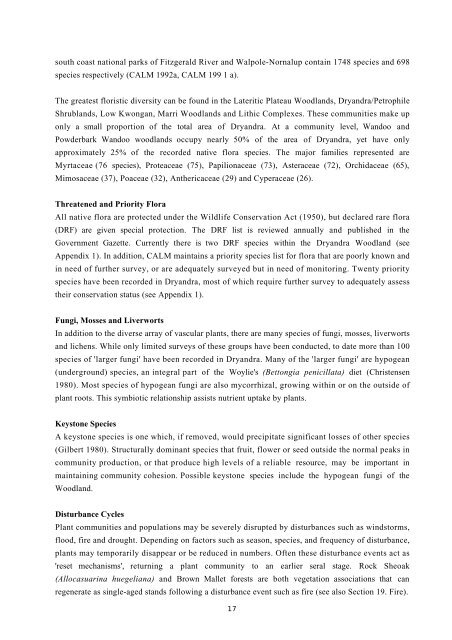Dryandra Woodland - Department of Environment and Conservation ...
Dryandra Woodland - Department of Environment and Conservation ...
Dryandra Woodland - Department of Environment and Conservation ...
You also want an ePaper? Increase the reach of your titles
YUMPU automatically turns print PDFs into web optimized ePapers that Google loves.
south coast national parks <strong>of</strong> Fitzgerald River <strong>and</strong> Walpole-Nornalup contain 1748 species <strong>and</strong> 698<br />
species respectively (CALM 1992a, CALM 199 1 a).<br />
The greatest floristic diversity can be found in the Lateritic Plateau <strong>Woodl<strong>and</strong></strong>s, <strong>Dry<strong>and</strong>ra</strong>/Petrophile<br />
Shrubl<strong>and</strong>s, Low Kwongan, Marri <strong>Woodl<strong>and</strong></strong>s <strong>and</strong> Lithic Complexes. These communities make up<br />
only a small proportion <strong>of</strong> the total area <strong>of</strong> <strong>Dry<strong>and</strong>ra</strong>. At a community level, W<strong>and</strong>oo <strong>and</strong><br />
Powderbark W<strong>and</strong>oo woodl<strong>and</strong>s occupy nearly 50% <strong>of</strong> the area <strong>of</strong> <strong>Dry<strong>and</strong>ra</strong>, yet have only<br />
approximately 25% <strong>of</strong> the recorded native flora species. The major families represented are<br />
Myrtaceae (76 species), Proteaceae (75), Papilionaceae (73), Asteraceae (72), Orchidaceae (65),<br />
Mimosaceae (37), Poaceae (32), Anthericaceae (29) <strong>and</strong> Cyperaceae (26).<br />
Threatened <strong>and</strong> Priority Flora<br />
All native flora are protected under the Wildlife <strong>Conservation</strong> Act (1950), but declared rare flora<br />
(DRF) are given special protection. The DRF list is reviewed annually <strong>and</strong> published in the<br />
Government Gazette. Currently there is two DRF species within the <strong>Dry<strong>and</strong>ra</strong> <strong>Woodl<strong>and</strong></strong> (see<br />
Appendix 1). In addition, CALM maintains a priority species list for flora that are poorly known <strong>and</strong><br />
in need <strong>of</strong> further survey, or are adequately surveyed but in need <strong>of</strong> monitoring. Twenty priority<br />
species have been recorded in <strong>Dry<strong>and</strong>ra</strong>, most <strong>of</strong> which require further survey to adequately assess<br />
their conservation status (see Appendix 1).<br />
Fungi, Mosses <strong>and</strong> Liverworts<br />
In addition to the diverse array <strong>of</strong> vascular plants, there are many species <strong>of</strong> fungi, mosses, liverworts<br />
<strong>and</strong> lichens. While only limited surveys <strong>of</strong> these groups have been conducted, to date more than 100<br />
species <strong>of</strong> 'larger fungi' have been recorded in <strong>Dry<strong>and</strong>ra</strong>. Many <strong>of</strong> the 'larger fungi' are hypogean<br />
(underground) species, an integral part <strong>of</strong> the Woylie's (Bettongia penicillata) diet (Christensen<br />
1980). Most species <strong>of</strong> hypogean fungi are also mycorrhizal, growing within or on the outside <strong>of</strong><br />
plant roots. This symbiotic relationship assists nutrient uptake by plants.<br />
Keystone Species<br />
A keystone species is one which, if removed, would precipitate significant losses <strong>of</strong> other species<br />
(Gilbert 1980). Structurally dominant species that fruit, flower or seed outside the normal peaks in<br />
community production, or that produce high levels <strong>of</strong> a reliable resource, may be important in<br />
maintaining community cohesion. Possible keystone species include the hypogean fungi <strong>of</strong> the<br />
<strong>Woodl<strong>and</strong></strong>.<br />
Disturbance Cycles<br />
Plant communities <strong>and</strong> populations may be severely disrupted by disturbances such as windstorms,<br />
flood, fire <strong>and</strong> drought. Depending on factors such as season, species, <strong>and</strong> frequency <strong>of</strong> disturbance,<br />
plants may temporarily disappear or be reduced in numbers. Often these disturbance events act as<br />
'reset mechanisms', returning a plant community to an earlier seral stage. Rock Sheoak<br />
(Allocasuarina huegeliana) <strong>and</strong> Brown Mallet forests are both vegetation associations that can<br />
regenerate as single-aged st<strong>and</strong>s following a disturbance event such as fire (see also Section 19. Fire).<br />
17

















